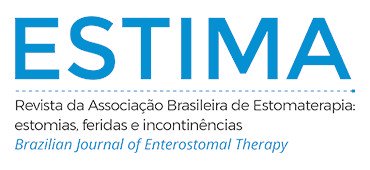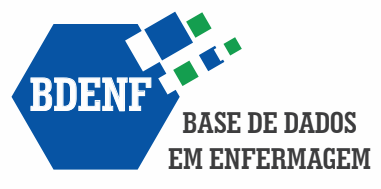POST-PROSTATECTOMY INCONTINENCE AND NURSING CARE: AN INTEGRATIVE REVIEW
Abstract
Objective: To identify nursing actions corresponding to assistance in post-prostatectomy urinary incontinence (PPUI). Method: This is an integrative review conducted in PubMed Central, ScienceDirect, Scopus and Web of Science, using the English terms “post-prostatectomy incontinence” and “nursing care,” combined with the Boolean operator AND. Articles published as full text or articles in press, within the open access system, without distinction of languages or year of publication, were included. Results: The initial search found 477 papers, but only six met the eligibility criteria. The five types of nursing actions identified were pelvic floor muscle training; urine stream interruption test with Unit Under Test timer; psychological nursing intervention program;telephone nursing support;and continuous post-prostatectomy nursing care, together with the previous interventions. Most studies showed good methodological quality and low risk of bias. Conclusion: The present review allowed the identification of different types of management of PPUI by nursing, even considering that the scenario of studies on the area is still scarce. It is expected that this review may be useful for the development of quality nursing care protocols for PPUI.
Downloads
Metrics
References
Carvalho AL, Pinto SA, Santos WG. CRISP3 glycoprotein: a good biomarker for prostate cancer? Jornal Brasileiro de Patologia e Medicina Laboratorial 2021;57:1–7.
Song C, Doo CK, Hong JH, Choo MS, Kim CS, Ahn H. Relationship between the integrity of the pelvic floor muscles and early recovery of continence after radical prostatectomy. J Urol 2007;178(1):208–11. https://doi.org/10.1016/j.juro.2007.03.044
Instituto Nacional de Câncer (BR). Estatísticas de câncer [internet]. INCA. [cited 2022 may 24]. Available at: https://www.gov. br/inca/pt-br/assuntos/cancer/numeros/
Rosoff JS, Savage SJ, Prasad SM. Salvage radical prostatectomy as management of locally recurrent prostate cancer: Outcomes and complications. World J Urol 2013;31(6):1347–52. https://doi.org/10.1007/s00345-013-1029-z
Izidoro LCR, Soares GB, Vieira TC, Orlandi FS, Polido Júnior A, Oliveira LMAC, et al. Health-related quality of life and psychosocial factors after radical prostatectomy. Acta Paul Enferm 2019;32(2):169–77. https://doi.org/10.1590/1982-0194201900024
Kakihara C, Sens Y, Ferreira U. Effect of functional training for the pelvic floor muscles with or without electrical stimulation in cases of urinary incontinence following radical prostatectomy. Braz J Phys Ther 2007;11(6):481–6. https://doi.org/10.1590/s1413-35552007000600010
Valença MP, Albuquerque AFLL, Rocha GMS, Aguiar APD. Cuidados de enfermagem na incontinência urinária: Um estudo de revisão integrativa. ESTIMA Braz J Enterostomal Ther, 2016;14(1):43-9. https://doi.org/10.5327/Z1806-3144201600010007
Roman AR, Friedlander MR. Revisão integrativa de pesquisa aplicada à enfermagem. Cogitare Enferm 1998;3(2):109–12. https://doi.org/10.5380/ce.v3i2.44358
Botelho LLR, Cunha CCA, Macedo M. O método da revisão integrativa nos estudos organizacionais. Gestão e Sociedade 2011;5(11):121–36. https://doi.org/10.21171/ges.v5i11.1220
Available Translations [internet]. PRISMA: Transparent Reporting of Systematic Reviews and Meta-analyses. [cited 2022 may 24]. Available at: http://www.prisma statement.org/Translations/Translations.aspx
Page MJ, McKenzie JE, Bossuyt PM, Boutron I, Hoffmann TC, Mulrow CD, et al. The PRISMA 2020 statement: An updated guideline for reporting systematic reviews. BMJ 2021;372:71. https://doi.org/10.1136/bmj.n71
Jadad AR, Moore RA, Carroll D, Jenkinson C, Reynolds DJM, Gavaghan DJ, et al. Assessing the quality of reports of randomized clinical trials: Is blinding necessary? Control Clin Trials. Control Clin Trials; 1996;17(1):1–12. https://doi.org/10.1016/0197-2456(95)00134-4
Jalalinia SF, Raei M, Naseri-Salahshour V, Varaei S. The effect of pelvic floor muscle strengthening exercise on urinary incontinence and quality of life in patients after prostatectomy: A randomized clinical trial. J Caring Sci 2020;9(1):33–8. https://doi.org/10.34172/jcs.2020.006
Moore KN, Valiquette L, Chetner MP, Byrniak S, Herbison GP. Return to continence after radical retropubic prostatectomy: A randomized trial of verbal and written instructions versus therapist-directed pelvic floor muscle therapy. Urology 2008;72(6):1280–6. https://doi.org/10.1016/j.urology.2007.12.034
Robinson JP, Bradway CW, Nuamah I, Pickett M, McCorkle R. Systematic pelvic floor training for lower urinary tract symptoms post-prostatectomy: A randomized clinical trial. Int J Urol Nurs 2008;2(1):3–13. https://doi.org/10.1111/j.1749-771x.2007.00033.x
Robinson JP, Burrell SA, Avi-Itzhak T, McCorkle R. Validity testing of the stopwatch urine stream interruption test in radical prostatectomy patients. J Wound Ostomy Continence Nurs 2012;39(5):545–51. https://doi.org/10.1097/won.0b013e3182648055
Wang C, Song Z, Li S, Tai S. Extended nursing for the recovery of urinary functions and quality of life after robot-assisted laparoscopic radical prostatectomy: A randomized controlled trial. Support Care Cancer 2018;26(5):1553–60. https://doi.org/10.1007/s00520-017-3988-x
Yuan Y, Hu Y, Cheng JX, Ding P. Psychological nursing approach on anxiety and depression of patients with severe urinary incontinence after radical prostatectomy – A pilot study. J Int Med Res 2019;47(11):5689–701. https://doi.org/10.1177/0300060519878014
Ferreira JC, Patino CM. Randomização: Mais do que o lançamento de uma moeda. J Bras Pneumol 2016;42(5):310. https://doi.org/10.1590/s1806-37562016000000296
Oliveira MAP, Parente RCM. Entendendo ensaios clínicos randomizados. Bras J Video-Sur 2010;4:176–80.
Reis FB, Lopes AD, Faloppa F, Ciconelli RM. A importância da qualidade dos estudos para a busca da melhor evidência. Rev Bras Ortop 2008;43(6):209–16. https://doi.org/10.1590/s0102-36162008000600001
Sharma N, Srivastav AK, Samuel AJ. Randomized clinical trial: Gold standard of experimental designs-importance, advantages, disadvantages and prejudice. Rev Pesqui Fisioter 2020;10(3):512–9. https://doi.org/10.17267/2238-2704rpf.v10i3.3039
Carvalho MR, Silva FAMN, Silveira IA. Alternative therapies for early recovery of post-prostatectomy urinary continence: Systematic review. Enfermería Global 2018;17(2):542–84. https://doi.org/10.6018/eglobal.17.2.285871
Sayner A, Nahon I. Pelvic floor muscle training in radical prostatectomy and recent understanding of the male continence mechanism: A review. Semin Oncol Nurs 2020;36(4): 151050. https://doi.org/10.1016/j.soncn.2020.151050
Mata LRF, Silva AC, Pereira MG, Carvalho EC. Telephone follow-up of patients after radical prostatectomy: A systematic review. Rev Latino-Am Enfermagem 2014;22(2):337–45. https://doi.org/10.1590/0104-1169.3314.2421
Caetano R, Silva AB, Guedes ACCM, Paiva CCN, Ribeiro GR, Santos DL, et al. Desafios e oportunidades para telessaúde em tempos da pandemia pela COVID-19: Uma reflexão sobre os espaços e iniciativas no contexto brasileiro. Cad Saúde Pública 2020;36(5):e00088920. https://doi.org/10.1590/0102 311x00088920
Downloads
Published
How to Cite
Issue
Section
License
Copyright (c) 2022 Vanessa Bezerra Eufrasio, Erica Joana Vieira Pita, Isabel Monique Leite Romualdo, Izadora Gonçalves Ribeiro Amorim, Luis Fernando Reis Macedo, Sueni Ferreira Batista de Assis

This work is licensed under a Creative Commons Attribution 4.0 International License.

























